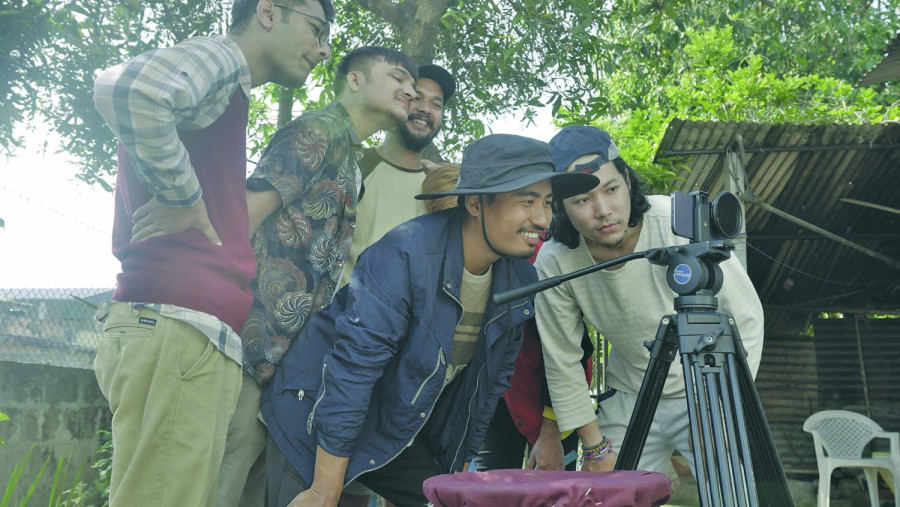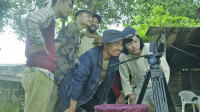Entertainment
No star cast, no cost—just an iPhone
These emerging filmmakers overcame financial constraints by shooting their film ‘A Place Under the Sun’ entirely on an iPhone 14 Pro Max.
Sanskriti Pokharel
Jason Lopchan is the director of ‘A Place Under the Sun’, the first feature film in Nepal to be shot entirely on an iPhone 14 Pro Max. Many assumed they chose to shoot on an iPhone as a gimmick to grab attention. “But that’s far from the truth,” Lopchan says. “If we had the budget, we would have never used a phone to shoot the film.”
For Lopchan, it was a matter of necessity, not strategy. Instead of letting financial challenges halt the filmmaking, he and his team turned to this unlikely solution.
Lopchan graduated from the Oscar International College of Film Studies in 2019, specialising in direction and screenwriting. After graduation, he started his filmmaking journey. ‘A Place Under the Sun’ is his second project.
When his first film was set to be released in 2021, it was stalled due to some issues. The producer flew overseas, leaving the team in limbo. The film has not been released yet. Disappointed, Lopchan and his team decided to produce the film themselves to acquire all the power, including the choice of release date.
Creating a film demands a significant financial investment, often beyond the reach of a recent college graduate. For ‘A Place Under the Sun’, a small team of ten cast and crew members worked together—four of them also served as producers. They managed to gather the required funds, resorting to every possible avenue, even seeking help from their parents.
Convincing his parents was no easy task for Lopchan. Initially doubtful, they questioned his project, saying, “You’ve worked on a film before, but we’ve never seen it. How can we trust you with such a large amount when we’re unsure it will be used wisely?” However, Lopchan’s vision eventually persuaded them to support him.
“There was no strict rule that we had to contribute a specific amount of money. We simply gathered whatever we could and kept moving forward,” says Lopchan.
Seeking sponsorships was a futile effort. From their experience, they knew that companies prioritise star power and face value over the content of a film. Since ‘A Place Under the Sun’ featured no star cast—only recent graduates from the same college—no companies were interested in sponsoring the project.
The script for ‘A Place Under the Sun’ was written during Lopchan’s final year of college. Reflecting on that time, he shares, “Back then, apart from assignments, we didn’t have much to do. I used to write scripts to practice screenwriting.” What began as a college exercise became the foundation for the movie. The script underwent revisions and was later finalised for production.
Lopchan and his peers followed their instructors’ advice to craft budget-friendly stories that could be filmed in one location. Lopchan developed a script that balanced creativity with practicality. Despite the project’s budget-friendly and practical nature, the dream of turning it into a film would have been unattainable if they had to rent a camera. Hiring a camera is not enough in itself; it also requires other equipment and technicians. So it exceeded their budget.
A discussion about how to proceed sparked an idea: “What if we shoot with an iPhone?”
They began researching whether films had been made this way and watched a few examples, including ‘Unsane’ and ‘High Flying Bird’. These films inspired and gave them confidence.

Prabin Limbu, the movie cinematographer, says, “Hiring a camera comes with a time limitation. It’s booked for a fixed number of days. The camera rental cost increases if unforeseen circumstances extend the shooting schedule. There’s constant pressure to wrap up filming within the allotted time. To stay within budget, we’d have to rush through the shoot, potentially compromising the quality of the final output.”
Opting to shoot on an iPhone gave them freedom. They could afford to make mistakes, experiment, and learn without time constraints. Most importantly, it saved them money, which they redirected to post-production.
However, the iPhone also did not belong to any crew members. It belonged to Limbu’s cousin. One of the members owned an iPhone 13. But Limbu’s cousin had an iPhone 14 Pro Max. They somehow managed to cajole her into lending them her phone.
During the shoot, Limbu, the cinematographer, and Lopchan, the director, worked without assistants. Lopchan often filled in as a clap boy or camera assistant between takes. Likewise, the entire ten-member crew juggled multiple roles. “If a scene involved two actors, the other actor would help the director or cinematographer instead of staying idle,” Lopchan explained. This collaborative effort helped the team cut costs significantly. “In film school, we learned to do every task without relying on assistants,” Limbu says.
However, shooting the film with an iPhone was challenging. One of the main problems was the phone’s overheating. There were many instances when the phone would go off, causing them to halt shooting.
“We used to shoot for 30 to 45 minutes, then for 10 to 15 minutes. We took the phone inside a room and placed it under the fan to cool it down,” says Lopchan. Moreover, the shots were flat and lacked depth, making them look less cinematic. Since the director did not have a monitor, he had no choice but to examine the shots on his phone’s display.
Post-production took a lot of time. The crew members handled editing, but audio became the main problem. Studio charges for dubbing were expensive. They did not have a sufficient budget. To allocate a budget, they started searching for sponsorship. Thankfully, this time, they got a few sponsors.
With minimal conditions, a co-producer agreed to join the team, which eased some of their challenges. This support allowed them to complete the dubbing process.
Once the film was finished, the team approached distributors, hoping to bring ‘A Place Under the Sun’ to theatres. However, their efforts were repeatedly rejected. Distributors and theatre owners dismissed the film, pointing to its lack of a star cast and the fact that it was shot on an iPhone.
“They didn’t even want to watch it,” shares Lopchan. “We would have understood if they had at least seen the movie and disapproved. But they weren’t interested at all.”
With little hope of a theatrical release, the team began exploring alternative platforms. Initially, they considered releasing the film on YouTube. However, out of the blue, Lopchan recalled an Italian filmmaker he had worked with during college and decided to reach out to him on Instagram. He explained the situation and asked for advice.
The filmmaker expressed interest and requested to watch the movie. The final sound design was still incomplete, so the team sent him a rough cut with subtitles. After viewing it, the filmmaker responded enthusiastically and suggested pitching the movie to streaming platforms.
This was a breakthrough for Lopchan and his team. They signed a contract, and after seven months of waiting, ‘A Place Under the Sun’ premiered on Amazon Prime Video. The film is now being considered for other OTT platforms as well.

The team found an alternative solution to make the film accessible to Nepali viewers. After consulting with filmmaker Nischal Basnet, they partnered with MSM Video, where the movie is now available. “We’ve received messages asking where they can watch the film. Thanks to Basnet’s suggestion, Nepali viewers can now access it,” Lopchan shares.
However, Lopchan reveals a recurring question his team has encountered: “If films can be shot on mobile phones, should professional filmmakers sell their cameras?” While the debate over mobile filmmaking challenging traditional cinema continues, a more pressing question emerges: How can aspiring filmmakers carve their path in the industry without daring to innovate and adapt?
_______
A Place Under The Sun
Director: Jason Lopchan
Cast: Min Ghalan, Meera Gurung, Amshu Sharma
Language: Nepali
Available on: Prime Video, MSM Video




 19.12°C Kathmandu
19.12°C Kathmandu










